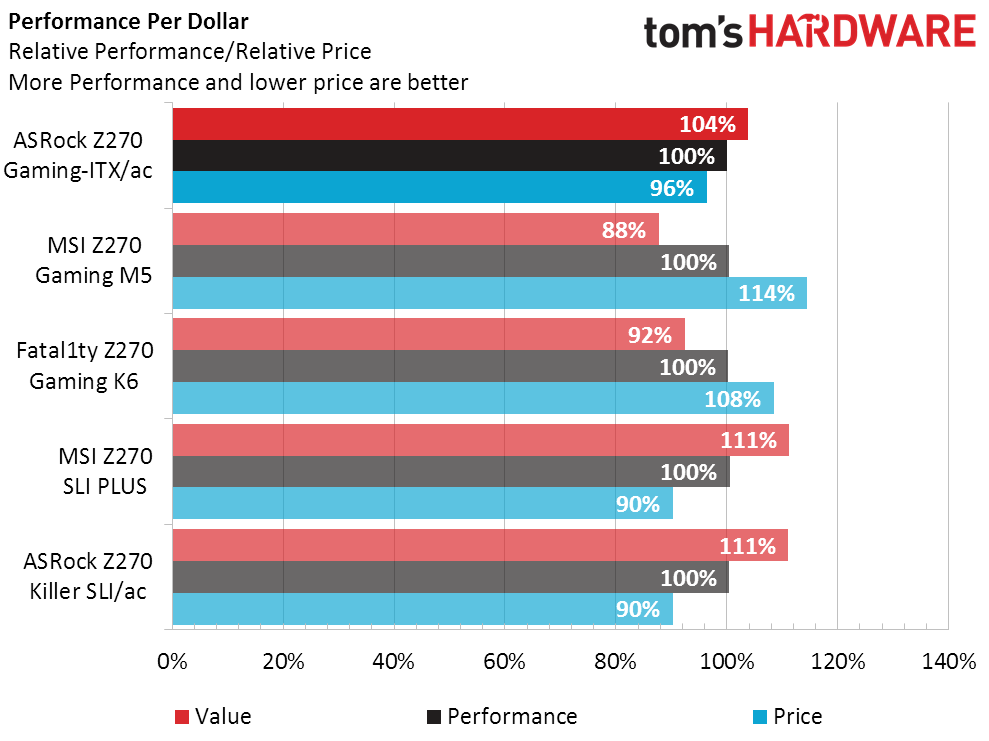ASRock Z270 Gaming-ITX/ac Motherboard Review
Why you can trust Tom's Hardware
Final Analysis
Performance wise, the Z270 Gaming-ITX/ac’s DDR4-4000 setting is about equal to MSI’s DDR4-3867. That means its memory O/C win is actually just ASRock playing catchup on bandwidth.
With little performance difference, cheaper boards always lead the Performance Per Dollar chart. It’s only retained for entertainment (and legacy) purposes, because what we need to consider most earnestly is how many features we get for our money. Oh, and overclocking is a feature.
We’re going to set aside the notion that it costs more to pack the chips more densely on a smaller board, even though one of the larger production costs is putting chips and connectors on the underside, because the smaller PCB should offset some (if not all) of that added cost. If we instead look at on-board features such as the Z270 Gaming-ITX/ac’s single-port, half-speed Thunderbolt 3 controller, the MSI Z270 SLI Plus has a two-port USB 3.1 Gen 2 controller with the same throughput. Users who have Thunderbolt 3 storage will want all that bandwidth on a single port, and users who have a Thunderbolt 3 connected display will likewise need the controller, but users who just want two 10Gb/s USB ports will likely prefer the USB 3.1 solution. But the Z270 SLI Plus doesn’t have a Wi-Fi controller either.
The Z270 Killer SLI/ac does have the Wi-Fi controller, but it doesn’t have Thunderbolt 3, not even at half speed, or the dual-port USB 3.1 Gen2 substitute. Furthermore, its Wi-Fi controller is a cheaper 433Mb/s version, compared to the Z270 Gaming-ITX/ac.
Both the Z270 Gaming M5 and Z270 Gaming K6 have more ports, but they also cost more. From an added features perspective, the little Z270 Gaming-ITX/ac looks like a reasonable deal.
Of course there is the one problem that all Mini-ITX motherboards are relatively overpriced compared to ATX, simply because equality of added features ignores the inequality of basic features. Big boards have more slots. The two slots connected to the CPU usually have four two-lane switches to allow SLI or CrossFire, and those switches cost money. And all four of the big boards have twice as many M.2 slots.
Yet we can’t beat the system: If we accept the reality that Mini-ITX boards are priced similarly on a per-added-feature basis to ATX boards, despite the lower connector count, we must concede that the Z270 Gaming-ITX/ac is a reasonable value. And for that it gets our basic stamp of approval.
Get Tom's Hardware's best news and in-depth reviews, straight to your inbox.
MORE: Best Motherboards
MORE: How To Choose A Motherboard
MORE: All Motherboard Content
-
dbrees I myself have the H270 version of this board and I've found it works very well in my Ncase M1.Reply -
logainofhades I almost went with this board, but nobody could keep them in stock, so I went with the Asus Strix Z270 itx board instead.Reply -
Nintendork Why would you want an inferior platform when you got Ryzen.Reply
Ryzen 7 1700 8c/16t for $299 is a no brainer choice. i7 6900K for 1/3 the price. -
logainofhades Reply19782752 said:Why would you want an inferior platform when you got Ryzen.
Ryzen 7 1700 8c/16t for $299 is a no brainer choice. i7 6900K for 1/3 the price.
AM4 mini itx boards are all but non existent.
19783149 said:only 16 lanes, skylake has 20
Not sure what your point is on this, but Mini ITX boards only have a single PCI-E slot.
-
nzalog I'd add "no RGB LED" as a Pro to that list.Reply
This was the first board I went with but then chose to go with the ASUS Z270 Strix ITX simply because of the additional M.2 slot.

